Tarptent StratoSpire Li
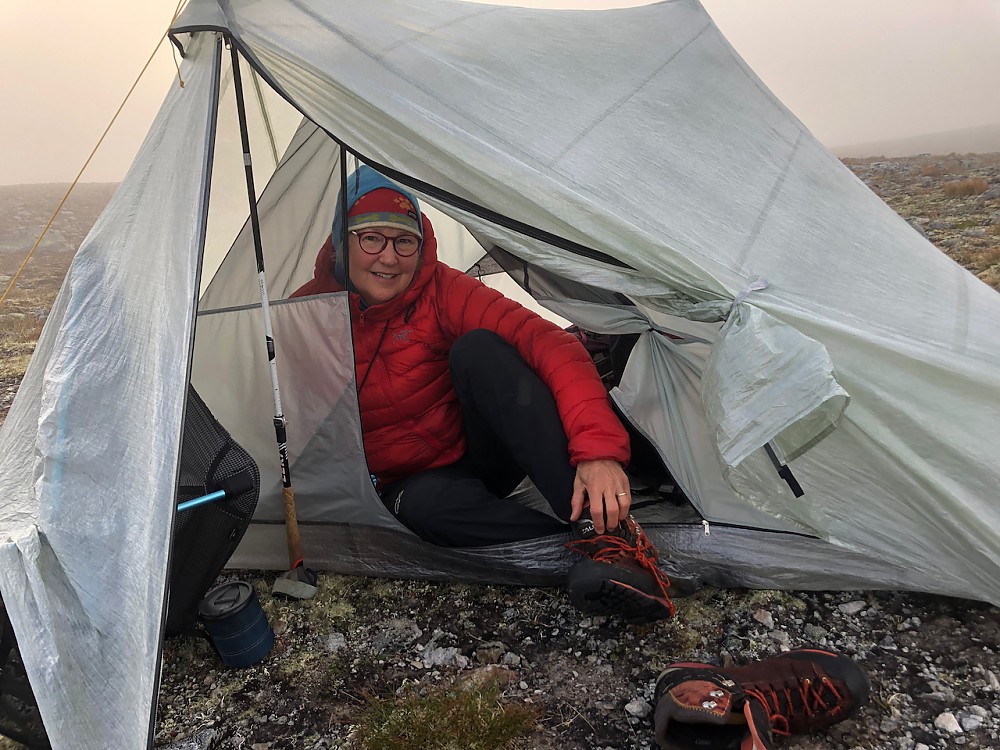
A solid UL trekking pole tent with top-notch materials and workmanship. Bare-minimum sleeping space for two, short on headroom for sleepers, and limited vestibule area.
Pros
- Ultralight fully-enclosed double wall tent
- Cool looking
- Solid materials
- Coated zippers on fly
- Twin doors
- Magnetic hold-opens for open-fly configuration
Cons
- Finicky to pitch, often requires readjustment
- Small vestibules
- Floor space for two 20-inch mattresses and no more
- A little claustrophobic due to low ceiling at head and foot ends
“…backpackers can choose to be overnight hikers or backcountry campers. The former love to hike all day and camp only so that they can recharge for another day of hiking. The latter prefer a more leisurely itinerary and/or to partake in an extracurricular activity, like fishing, birding, and photography.”
-- Andrew Skurka
I prefer to think of that choice as a spectrum (or maybe something more multidimensional), from the solo UL hiker shivering through a hail storm to the yokels lugging in a full cooler for a party at the pond. We all get to choose where we want to be on the spectrum, maybe even on a trip-by-trip basis. And gear choices have a lot to say about how we make that choice.
When we go out together, my wife and I are somewhere between the middle and the UL side of that spectrum. I’d call us comfort-light backpackers. Some days we go long and cover some territory, on others we get into camp in early- to mid-afternoon and hang around camp reading books, maybe swimming if the weather’s good, or nap or hang out in the tent if it’s windy, rainy, or buggy. But like any backpacker we are always trying to lighten up, juggling gear weight against comfort, safety, durability, and necessity.
It was in that spirit (and after finally paying off our mortgage) that we decided to go all in on the Tarptent StratoSpire Li. We were won over by its light weight (of course), double wall and fully enclosed design, the reputation of Dyneema as a tough, ultralight material for making tents, and Tarptent’s stellar reputation for both design and customer service. I went in for the solid body model because I thought it would be better for Scandinavian mountain conditions, where it’s often chilly even in summer and wind can carry fine rain and mist through mosquito netting.
First look
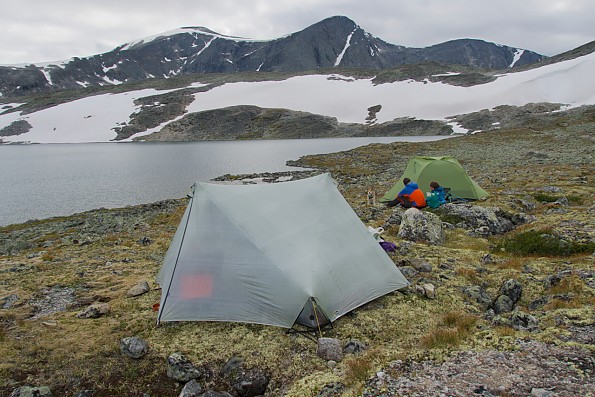
This is a cool-looking tent. The silvery, slightly translucent fly, and symmetrical polygonal shape of the outer tent give it a space age look, belied by the wrinkles of the Dyneema fabric. The video on Tarptent’s web page circles in on it from above, emphasizing the symmetrical, hexagonal footprint. Like many other UL tents, it uses trekking poles instead of dedicated poles as the main supports. His and her doors and vestibules are always a plus.
Zipping open the fly on one side reveals a surprise—the rectangular floor isn’t square to the ridgeline defined by the two poles, instead positioned diagonally to where you might expect it to be. The poles are off-center but kitty corner on the long sides of the rectangle, giving more room for entry and exit via the double side doors. Tarptent’s floor plan diagram helps explain:
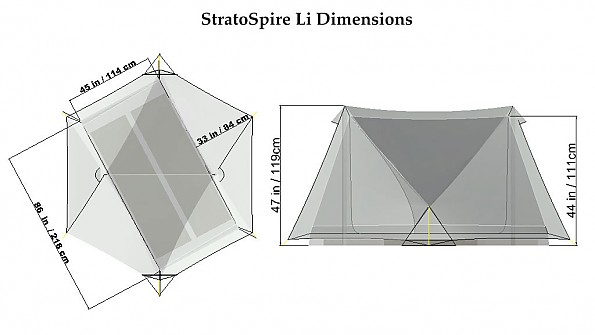
That leaves room under the fly for a pair of triangular vestibules, each a bit under 0.5 m2/10 ft2 in area, big enough to stash a pack on the other side of the pole from the door, a pair of boots outside the door, but not a whole lot more because of the acute corners and steeply sloping fly. I can sort of sit in my comfy chair with by head under the peak, but my feet would stick out in the rain, and there’s no place to set up a stove for sheltered cooking as I can do in a tent with a larger vestibule.
The solid wall version in its stuff sack weighs in at about 31 oz / 880 g, including six stakes but no poles. The full mesh version weighs about 0.7 oz / 20 g less than the solid version.
The tent rolls up and fits into a compact 16 in / 40 cm x 5 in / 13 cm diameter stuff sack, taking up minimal room inside or lashed to the outside of a pack. The nearly $700 price tag is what it takes to buy a UL tent made of premium materials.
Material matters
I had to read up on Dyneema fabric to find out what it’s all about. Dyneema itself is an ultra- high molecular weight polyethylene fiber that is said to be stronger than steel and takes some kind of wizardry to produce. Rather than being woven, it is laminated between two layers of polyester to produce Dyneema Composite Fabric (DCF, formerly known as Cuben Fiber), a lightweight, high tensile strength, and waterproof fabric that has become a preferred material for high-end UL tents like the Stratospire and other Tarptent Li models. It has almost no stretch and doesn’t sag when wet, allowing for a tight, low maintenance pitch. The fly material weighs in at 0.51 oz/yd2 (17 g /m2), and the floor at 1.0 oz/yd2 (33.5 g/m2).
In its materials description, Tarptent is honest enough to note that DCF doesn’t resist abrasion as well as silnylon and actually predicts about a 2/3 shorter lifespan for its DCF tents. I wasn’t aware of that when I ordered my Stratospire—I guess it’s part of the cost of the weight savings. In Tarptent Li models, the fly and floor seams are factory sealed with DCF tape—amen to that.
Above the DCF bathtub floor, the inner tent in our solid model is made of 10D ripstop nylon. The only mosquito netting on the inner tent is a pair of triangles on the top ca. 47 cm / 18" of the door walls—no stargazing in this tent, even when pitched without the fly.
Nice zippers
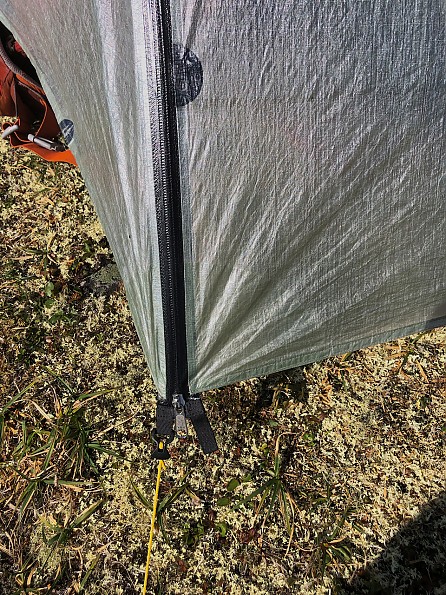
Some lightweight or UL tents use small zippers that don’t hold up well under the many daily openings and closings over months of use, especially in environments where dirt or sand can work into the zipper or slider. The YKK #5 coil zippers on the fly are relatively heavy duty and look to last the life of the tent. More importantly, they are coated on the outside for water tightness, leaving out the usual zipper flap found on earlier models and most other tents. Awesome—one of my pet peeves is that zipper flaps, whether on tent doors or sleeping bags, tend to regularly get caught up in and jam the zipper, requiring careful extrication to avoid damage to the zipper or fabric.

Rather than the usual simple tie line or clips, the fly can be parked open using small magnetic discs on strips of Dyneema tape, powerful enough to hold even against a little tension. This is clever, but you have to be sure to straighten the tape so that the magnet is rotated into the right position—if it’s flipped over the wrong way it will repel rather than click shut. But it releases with zero fiddling, very nice when zipping up for a midnight rain shower.
The inner door zippers are lighter weight but I think still more robust than on many other lightweight tents. The curved door zippers on each side have a pair of sliders that meet in the middle or anywhere along the zipper track. I like to station them at the curved lower corner of the door so that they are easy to find in the dark when going out for a nighttime pee. The doors are held open with simple elastic ties, maybe a little disappointing given the elegance of the magnets on the fly. Some kind of clip and loop would be easier to operate.
The pitch
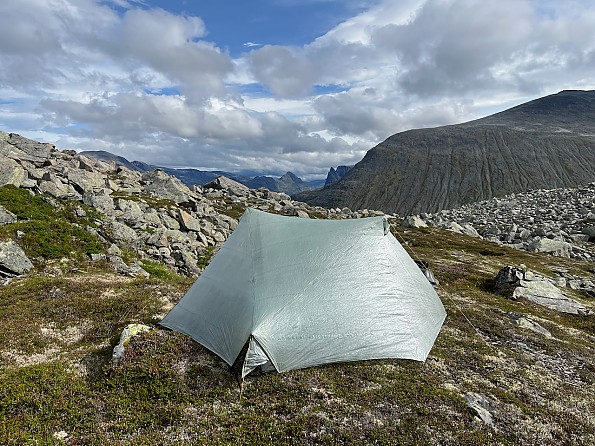
I’m not the first to observe that the StratoSpire can be a bit fiddly to pitch. It can be rolled up with the fly attached to the tent body, nice for pitching in the rain, but the tent can't be turtled so it can be necessary to decouple fly and body for drying out the tent in the field or at home. In principle the tent can be pitched with just six pegs, but I find that I want two more pegs (not included) for the guy lines coming off the ends of the ridge to get a good, taut pitch. This also allows both sides of the vestibule to open up in fair weather.
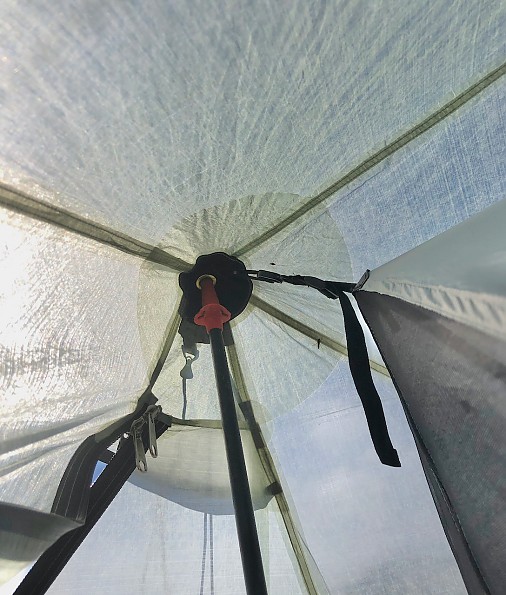
Like many UL tents, the StratoSpire is designed to use adjustable length trekking poles as the main means of support. The pole tips fit into solidly reinforced grommets on the fly, allowing a tight pitch without risking the poles breaking through and potentially puncturing the fly. Tarptent sells an adapter for folks wanting to use the poles upright and keep the grips clean, and small-gauge aluminum poles for those that don’t use trekking poles.
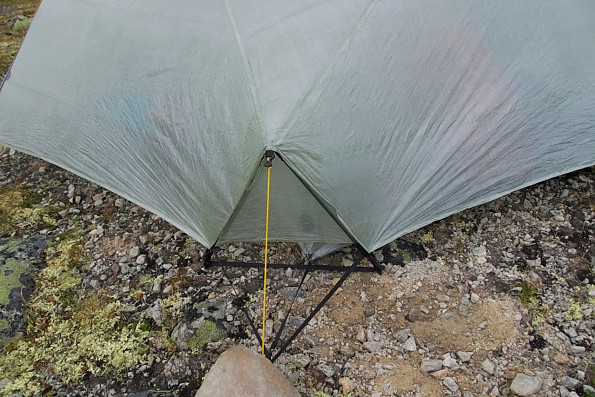
Two of the corners are supported by two 40 cm / 16" carbon fiber tubes forming an inverted V, designated Pitchloc by Tarptent. That lifts those corners of the fly a little higher off the ground and ensures the fly drips well clear of the floor. Both floor and fly are pulled tight using a single peg by webbing strips; the one running to the corner of the floor can be tightened, but the floor still ends up floating rather loosely at least until mattresses are laid out to square it off. In the pitching instructions from Tarptent, those corners get pegged out last, after raising the roof. The triangle of fly inside the Pitchloc corners can be opened for ground-level venting or sealed shut by Velcro strips.
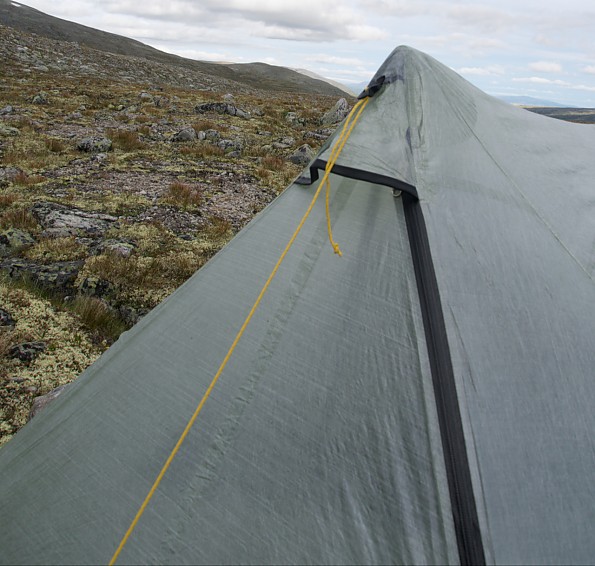
A pair of small vents at either end of the ridgeline, held open by strips of stiffer material, vent the air that comes in at the corners or under the fly for a little chimney effect. Still, as in most tents, we have experienced substantial condensation on the inside of the fly on cool nights.
For a solid pitch, I find that I want to go around and reset some of the pegs to draw the fly tight, and even then I don’t always get it as tight as I might like, especially on uneven or rocky ground. I guess you get better at it over time—some claim it can be pitched in as little as two minutes.
Tarptent says that both the fly and the interior tent can be pitched separately. It’s pretty clear how that would work with the fly but pitching the interior alone would require adding at least some cord loops to attach to the poles.
Tarptent provides a minimal DCF fabric patch kit for repairs if the fly or floor are damaged during use and sells a repair and spare parts kit for extra insurance.
Space issues
For me this is where the StratoSpire falls short (almost literally) as a two-person tent. Many of the glowing online reviews of the StratoSpire Li or the silnylon version StratoSpire 2 seem to be by people using it as a solo tent, although to be fair I have also seen a few that find it adequate for two and sometimes even a dog. Like many lightweight two-person tents, it may be a palace for one but rather tight for two. This is not a tent we’d want to wile away a rainy afternoon in.
At 114 x 218 cm / 45 x 86", the floor is just wide and long enough to accommodate a pair of 50 cm / 20" wide mattresses. With our two Neoairs coupled together, there’s no real room along the sides to roll up and stash clothing or other items. I’m well over 180 cm/ 6' tall and we both use long (196 cm / 77") mattresses so there’s also not much head or foot room for stashing clothing or reading materials.
The interior height depends a little bit on the length you set for the trekking poles but is nominally 111 cm / 44". That’s adequate for sitting up right by the poles, but because the roof slopes steeply down from the ridge to the corners there’s not a lot of sit-up room away from the ridgeline. We can sit sort of facing each other, with our backs to the poles, heads under the peaks and legs extending past each other’s hips. I can’t sit for long without back support and bringing our backpacker’s chairs in would be a bit tight, but I suppose possible if we each faced the low ends of the tent.
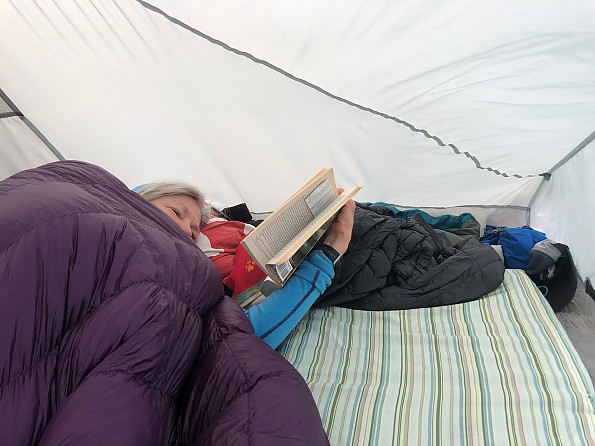
There’s also not a lot of headroom when sleeping. On the low corners of the tent the fabric is more or less right in your face when lying on your back, while on the Pitchloc corners it’s a little higher but still rather close. It ends up feeling a little claustrophobic when waking up periodically during the night or at the end of a night’s sleep. When I have used it as a solo tent, sleeping diagonally between the high corners, I still didn’t like having the ceiling so close to my face.
Many two-person backpacker tents have the same or similar floor dimensions as the StratoSpire 2, making them just sufficient for two sleepers but a little tight for anything else. But that is even more so in the Stratospire due to the very low head and foot ends.
There are only two small interior pockets, one beside each door, big enough for a mobile phone and a small headlamp and not a whole lot else. I for one would appreciate a bit more storage space to reduce clutter. Tarptent sells an add-in triangular pocket that can be hung overhead or along the side but it looks rather small and is something of an afterthought.
To give Traptent some respect: the Tarptent Dipole Li came out shortly after I ordered the StratoSpire and for $100 more might have served our purposes better. A pair of lightweight poles at head and foot ends give more headroom if not real sitting up room. But for the time being we're happy to pay the weight penalty and save the cost difference of a roomier, more conventional tent.
Word
As noted in reviews of other StratoSpire 2 models, despite it being a bit of a disappointment for us “comfort light” hikers, this can be a fine tent for solo backpackers or couples who are willing to sacrifice interior volume for light weight. For those folks, solid materials and smart design make it worth the price, again considering the weight premium. But after trying it out on a few weekenders and a solo trip or two on my part, we decided that it just wasn’t the right choice for our 25-day through hike of the Kungsleden in Sweden, where windy and sometimes rainy weather and copious bugs favor a tent with more interior volume and a roomy vestibule. The 8-peg pitch can require one or more rounds of readjustment, also a disadvantage in inclement conditions. We went back to our well-used Big Agnes Copper Hotel HV 2 with its roomy vestibule and headroom and were glad we did. We sold the StratoSpire to, hopefully, someone who can appreciate its better qualities and put it to good use.
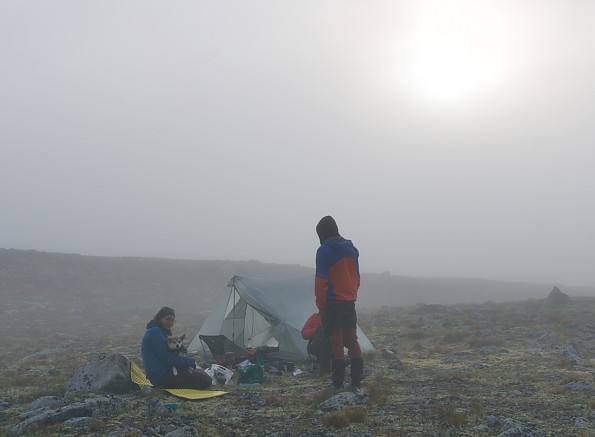
Background
As aging backpackers, we have individually and togetherly owned many different tents, including several lightweight backpacker models, and have used them over the decades on hikes of up to 25 days. We used the Stratospire Li for only five or six nights total, some in light rain, enough to decide that it wouldn't work for us.
Source: bought it new
Price Paid: About $700


